THE STATUES ON THE MAIN ALTAR
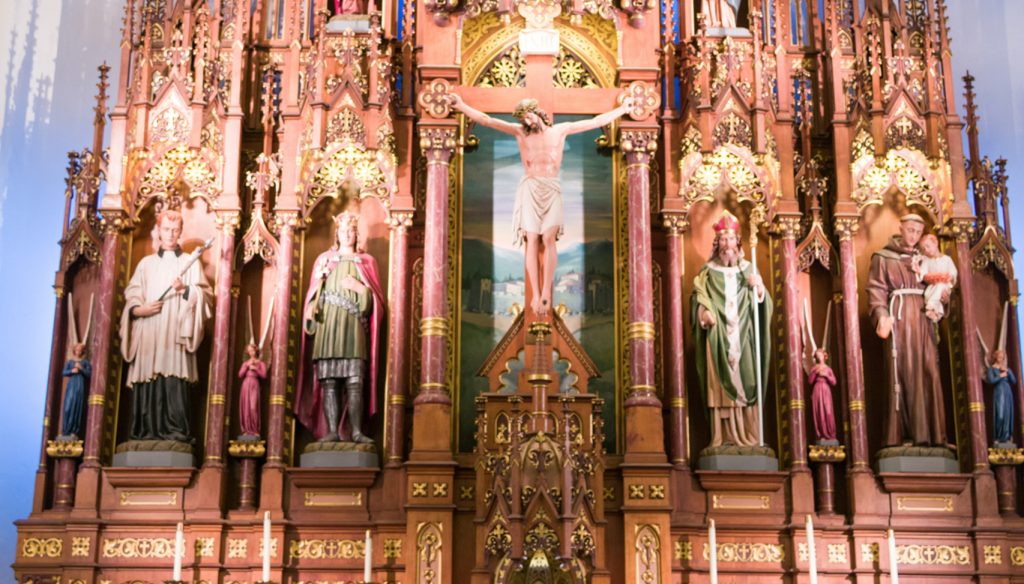
The first statue of four males calls to mind the young cleric who desired to become a priest, St. Aloysius Gonzaga. Dressed as a student for the priesthood, he admires the symbol of redemption, the Cross, and is an inspiration for young people. He lived in Italy from 1568 to 1591, and June 21st is his feast day. Dressed as a soldier prince, the next male saint holds the symbol of purity, a lily. This portrayal of St. Casimir, crowned prince of Lithuania-Poland defended his nation and his faith. Dying in 1482 at the age of 24, he gave much witness as a follower of Christ and an ardent devotee of Mary.
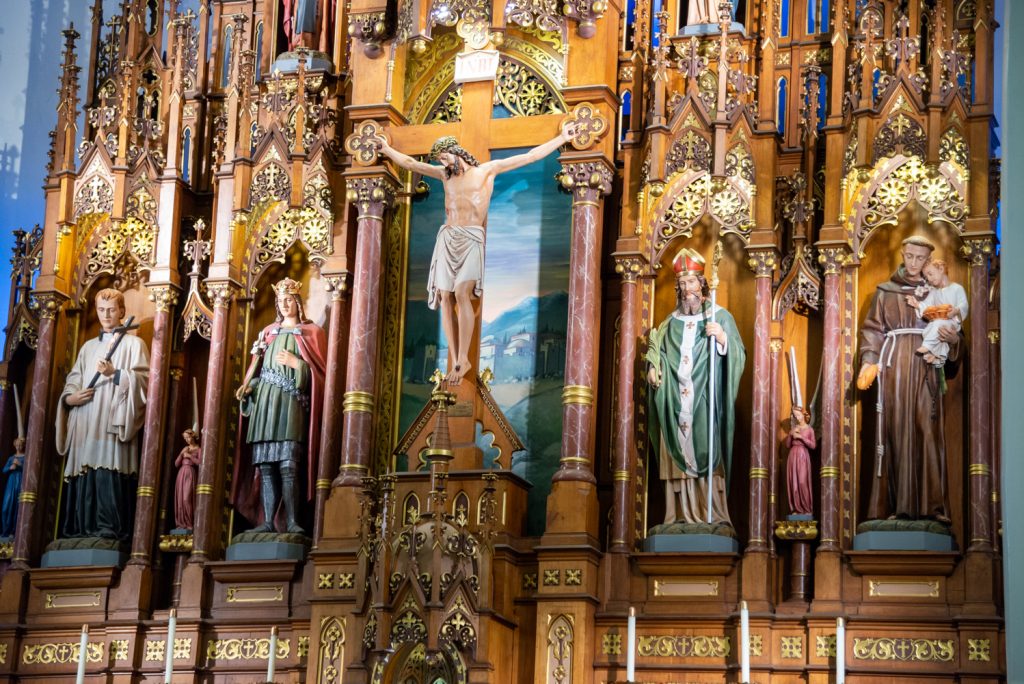
The statue of the bishop with the palm of martyrdom represents the renowned bishop of Krakow, Poland. Living in the 11th century, he vigorously defended the Christian moral life and fell at the sword of the angry king. St. Stanislaus is a principal patron of Poland and of Polish people everywhere. The next statue of a young man in a brown tunic holding a child represents St. Anthony of Padua. A powerful preacher and worker of miracles, he loved the poor and destitute and was favored by the Child Jesus. Italian by adoption, Portuguese by birth, Anthony is admired by many throughout the world, especially with the Tuesday novena and prayers to recover lost objects.
Removed during the 1970s renovations, a statue of a kneeling angel that was duplicated at the other side of the high altar. Scripture records angels are messengers of the Lord and are sent to help us. We also learned they are pure spirits who give heavenly homage and obedience to the Lord of the universe and remind us to do the same. Six other statues that were on the altar represented these pure spirits or angels.
Six brass candlestands grace the high altar and hold the lights necessary to celebrate the Mass and are likewise light for devotions and para-liturgical services. Sweet-smelling flowers and potted ferns are occasionally added to enhance the ceremonies and beautify the altars.
The golden door is the exterior of the tabernacle. Designed to recall the especially built tent of the desert and the Holy of Holies of David’s City, it now contains the consecrated hosts held in reserve for the sick.
THE ARTWORK OF THE HIGH ALTAR
The Latin Rite of the Catholic Church requires the continuation of the Last Supper Rite and the Sacrifice of Calvary in the worship of God. This was expected of us by the Son of God, Jesus Christ, when he said, “Do This in Remembrance of Me’. This is accomplished at the Mensa or table of the high wooden altar.

This gothic-style structure was hand carved in Europe about 1916. Made of linden tree wood, it was sent in pieces and re-assembled here to grace the sanctuary of the Church. You can note the gold leaf motifs, sections of brass and silver plating on the High Altar to highlight the tone of the wood. The two side altars match the gothic design found in this High Altar. Looking at the structure, you observe 3/4 life-size statues, candle holders, prostrating angel statues, a crucifix and a little golden door.
The wooden altar reaches to some 48 feet in height and extends to about 35 feet in width. Note the finely carved latticework and grape with wheat motifs.
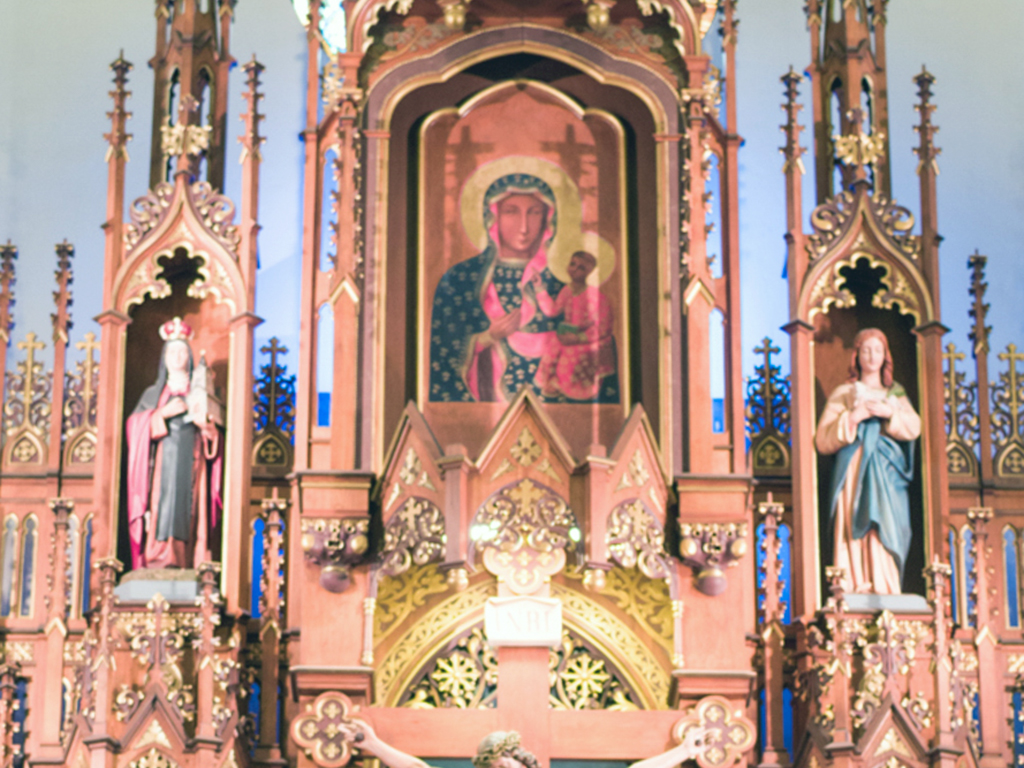
The statue of the crucified Christ recalls his ultimate Act of love for mankind. It raises above and beyond the other statues as it represents not just a man, but the Son of God.
The niche contains three statues: one of a lady, two of angels. The whole parish and church building is under the patronage of the Mother of God; thus, she receives a prominent place of honor. The angels represent the celestial homage given to the Mother of the Savior of the world. An icon, a flat Byzantine painting, is rolled up before the statue group on certain feasts and occasions. The statue of a lady with a royal crown and holding a church represents St. Hedwig, She was married to a prince and lived in Poland in the 13th century, St. Hedwig was exemplary in her life of faith and devotion and made many efforts to continue the work of God’s family on earth, the Church,
The statue of the young maiden dressed in a white tunic, holding a Iamb, recalls the twelve-year old Roman girl, Agnes. Beheaded for her conviction of faith in 32AD, she stands with a symbol of peace and love, the lamb.
THE HIGH ALTAR BASE RELIEF SCULPTURES
The Altar is both the table of the last Supper and place of Sacrifice of Calvary. Both elements are essential to the proper worship of God and both are scripture-based. Catholic Faith.
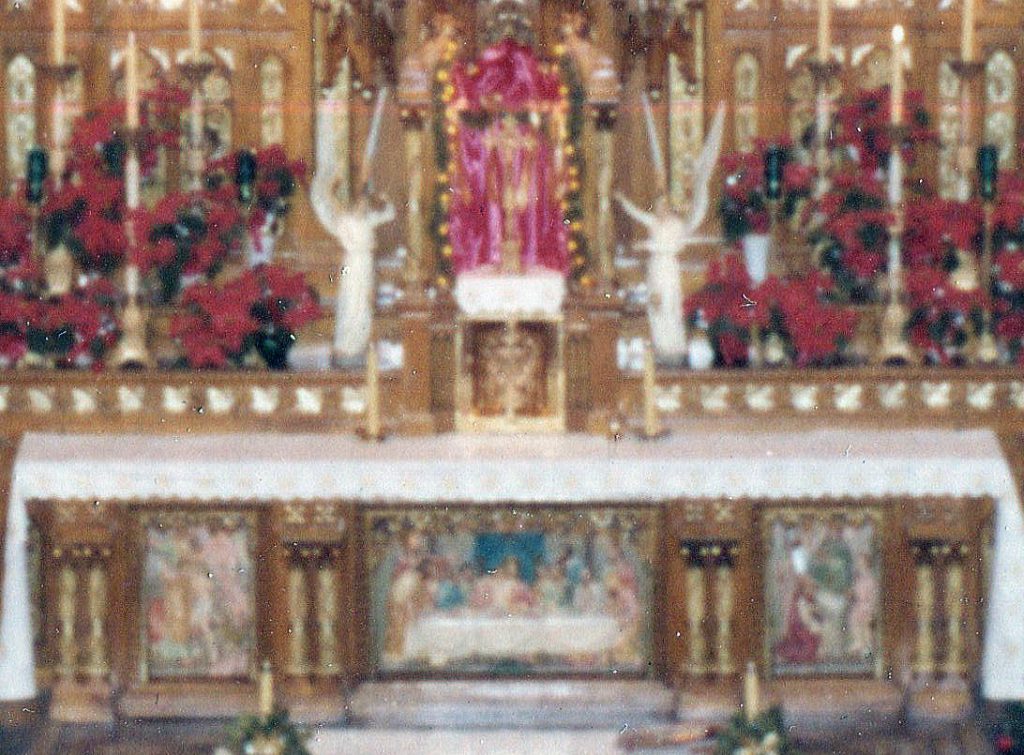
All three panels in connection with the Crucified Christ statue gave us the biblical support for the Eucharistic theology we have today. The crowning element is the Presence of Christ in the tabernacle behind the golden door. We are reminded of this by the burning red sanctuary lamp on the left wall of the sanctuary.
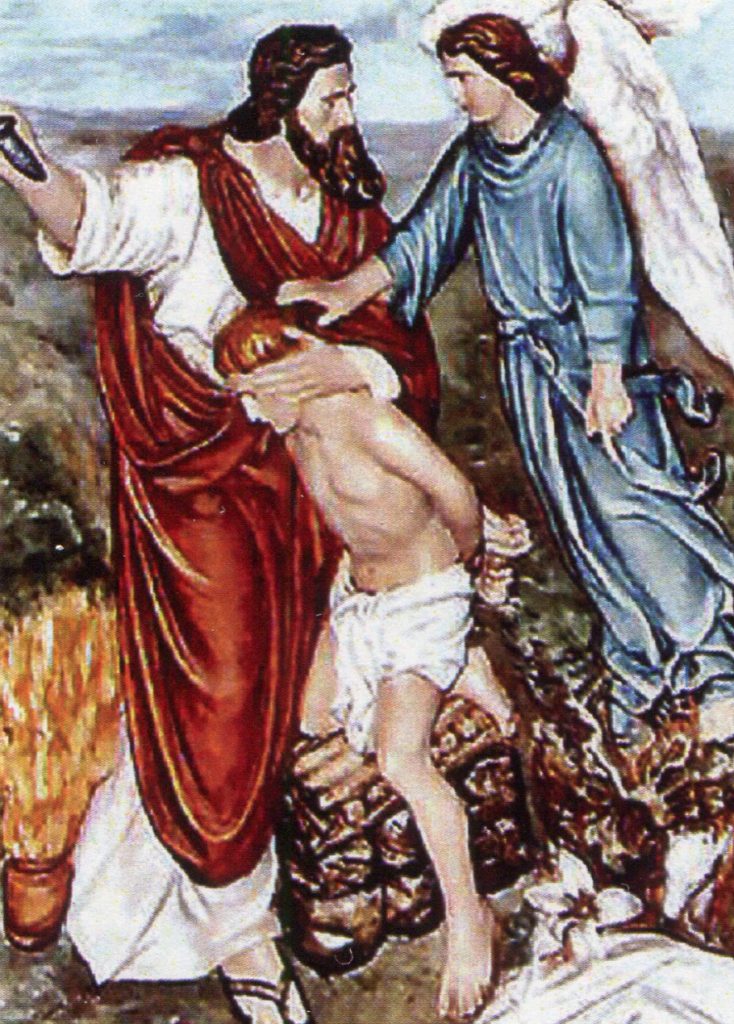
LEFT PANEL:
Three individuals are involved: a man, a boy, an angel. This panel portrays the obedient love of Abraham from the Book of Genesis. Called by God, Yahweh, to become a father of many nations, Abraham left his home in Ur, Babylon and went to Canaan. There he awaited the fulfillment of God’s promise. A son was born, Isaac. But despite delight, and happiness, a test of love, sacrificial death of the son was required by God. Obedient and loving, Abraham prepared the altar and was ready to sacrifice his only son, when God noted his love and rescued the boy by the angel. Isaac became the father of Jacob, an Old Testament, patriarch.
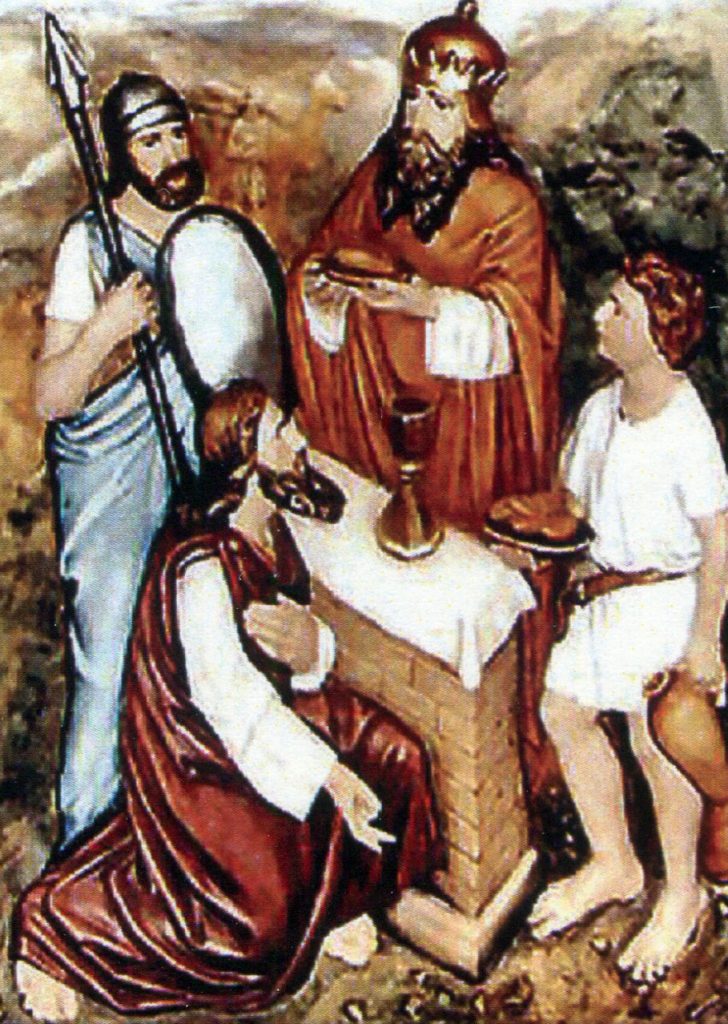
RIGHT PANEL:
Here are four persons gathered in the act of worship. The King of Salem in Canaan is rendering an offering of bread and wine to the Creator of the world. This Old Testament king was also a priest, named Melchizedech who will pre-shadow another offering of bread and wine. This relief is sculptured to fit the panel and to enhance the meaning of the high altar sacrifice.
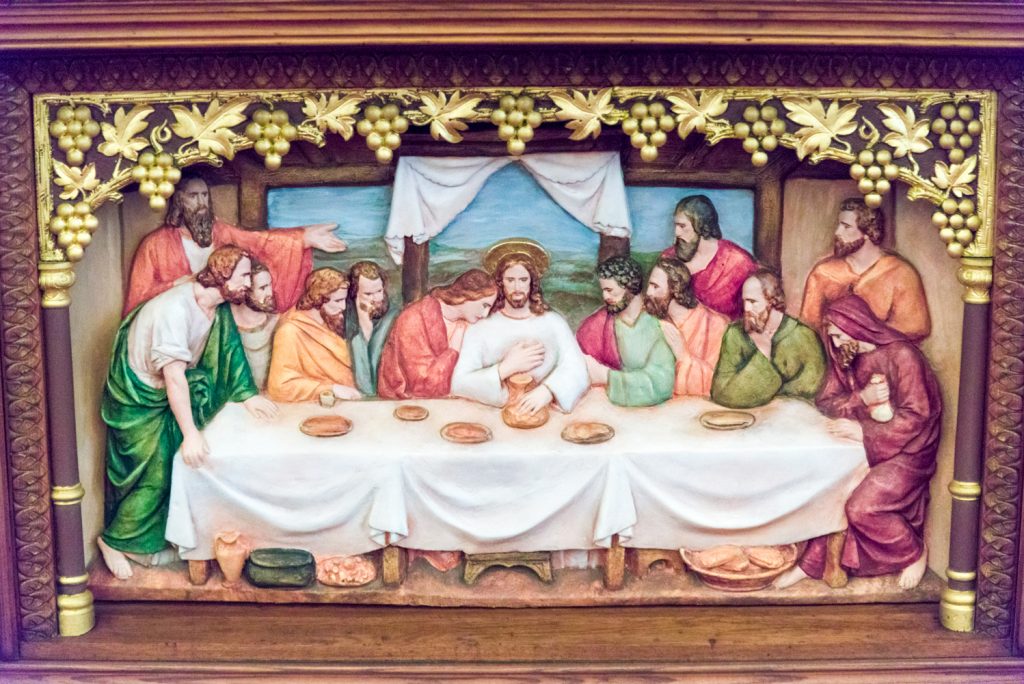
CENTER PANEL:
Easily identified as the Holy Thursday Last Supper Meal, we now see the New Testament offering of Bread and Wine by an only Son. The twelve hand-picked Apostles watch in awe as Jesus of Nazareth tells them to take the Bread and “Eat For This is My Body,” and to drink the Wine, “For This is my Blood.” The Son of God shares Himself so that others may be strengthened and reach the goal of this earthly pilgrimage, the eternal vision of God in Heaven.
SIDE ALTARS
Built to match the gothic design of the main altar, the two auxiliary or side altars form a trinity to indicate the Three Persons in One God. Formerly, each altar was in regular usage either as a place to celebrate Mass or to reserve the Blessed Sacrament on such occasions as Holy Thursday or Corpus Christi.
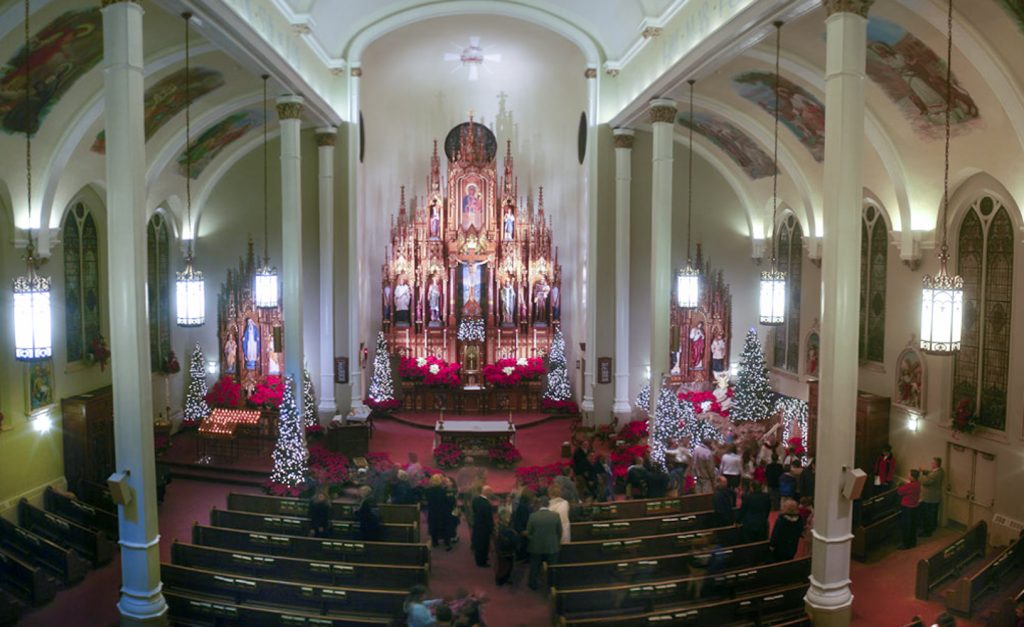
Removed during the 1970s renovation, the small statue representing the Child Jesus as a king, is a copy of one found in Prague, Czechoslovakia. Revered for many centuries, the Infant of Prague serves as a reminder of the kingship of the Christ Child. Periodically, outward garments are changed to match the seasonal colors of the liturgy.
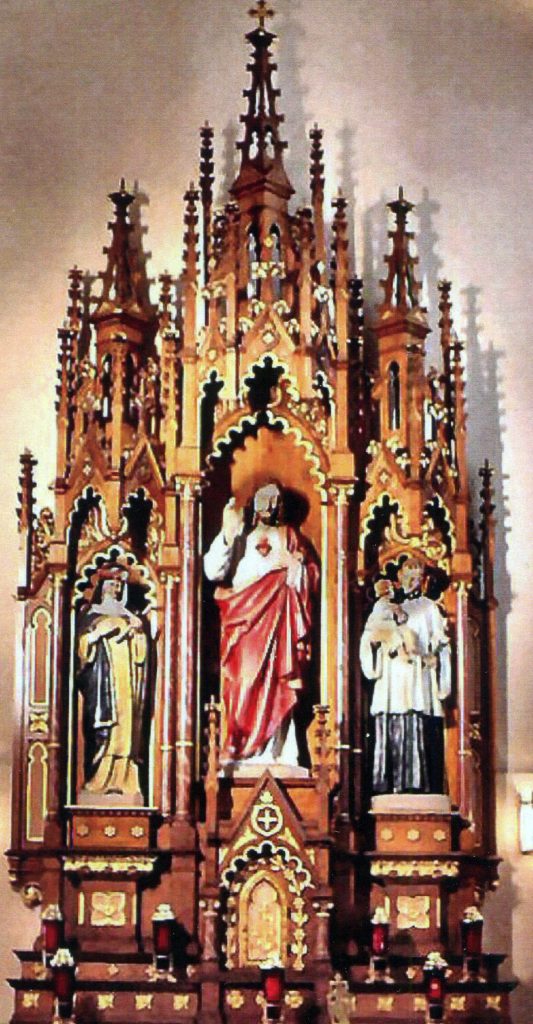
The statue of a young man holding a child calls to mind the young Polish lad, St. Stanislaus Kostka, born of a wealthy family, he was sent to school in Vienna, Austria, but his desire to become a Jesuit Priest was deep, thus he abandoned student life in Vienna and journeyed by foot to Rome to become a member of the Society of Jesus. While still a novice, he died of a lung ailment, yet is the first Jesuit Saint. He is a patron of all young people and model of deep love for God.

Dressed in the black and white habit of a Dominican Sister, the statue of a young girl to the left of the Sacred Heart, represents St. Rose of Lima. She was born in Lima, Peru, South America and desired to serve God fervently. Her virtuous life won her the honor of the people. She is the Patron Saint of Peru.
Removed during the renovations, Therese Martin of Liseaux in France became a Carmelite Nun and advanced to Mistress of Novices. Her “Little Way of love” is not only a book, but an inspiration to many as they call upon her for heavenly assistance. Her love for the Crucified Lord and the promise of roses is noted in the statue composition. She died at age twenty-four and was canonized in the 20th century.
The altar is made of linden-type wood and graced with carvings and metal insets. Used for special feast day occasions, the front piece can be removed to expose a statue of the departed Lord. Normally this is shown during Holy Week.

LEFT SIDE ALTAR
The center of the left side altar has a place for reservation of the Blessed Sacrament. This is used especially for Holy Thursday services. Built in the same gothic style, this side altar then compliments the others and completes this trinitarian notion devotion to Three Persons in One God.
The large statue in the center of the altar represents the Mother of Jesus, Mary of Nazareth. Dressed in the usual robes of a Jewish woman, she opens her hands to our service and displays the heart that loved God so much that she gave birth to His Son and Our Savior. The blue and white colors are traditional and remind us of our final destiny and condition of our immortal souls.

The statue of a young princess represents the virgin martyr, St. Barbara. Born and raised a pagan in a pagan country, she converted to Christianity and was imprisoned by her father, the king, in the royal tower. When she refused to denounce Christ as her spouse, Barbara was beheaded. A patron of miners and protector against storms, her feast is celebrated on December 4th.

Husband of Mary and foster-father of the Christ Child, St. Joseph stands next to Mary with Jesus on his arm. Silent though he was in scripture, his obedience to God and protection of the Holy Family has won him the devotion of millions and the title of Protector of the Church. A patron of laborers, fathers, husbands and invoked for a happy death, he is honored especially on March 19th of each year.
The statue to the left of the altar was of an elderly lady teaching a young maiden. This was removed during the renovations. Represented in this figure is St. Anne, the grandmother of Jesus and mother of Mary, the Mother of God’s Son. St. Anne is invoked by the sick and is honored on July 26th. A special shrine and basilica to her is found in deBrupre, Canada.
